Curry Powder Recipe (Mild & Madras)
Updated: February 1, 2024, By Swasthi
Curry Powder is a popular Indian spice blend used to spice and flavor curried dishes. This homemade version is easy to make and you won’t find anything as good as this in the stores. This Curry Powder acts as a thickener, imparts pleasant & subtle flavors to your curries. A lot of people do not like to use garam masala in their everyday cooking, yet want to impart delicate flavors to their dishes. If you think so, this Curry Powder is just for you! In this post I share 2 recipes – Mild Curry Powder and hot spicy Madras Curry powder.
Curry Powder originated in the Tamil cuisine, South India and is known as Kulambu thool or kuzhambu podi in Tamil. It is a staple in the Tamil speaking homes and is used in everyday vegetarian curries, gravies, tamarind based stews (kuzhambu) etc.
A spicier/hot version of this is commercially marketed as Madras Curry Powder, sometimes with more Spices added to it. A similar version also exits in the Telugu Cuisine and goes by the name Koora Karam meaning curry spice blend.
The earliest mention of curry powder refers to the times much before the British Era, when Tamil merchants (from Madras, currently Chennai) sold kari powder to British settlers In India.
The today’s term “Curry” is an anglicized word for the Tamil word “Kari”. Later, various versions of curry powder were created by Indians who were ferried by the British to other countries.
What is Curry Powder?
Curry Powder is a spice blend made with coriander seeds, cumin, mustard, fenugreek seeds, turmeric, dried red chilies, fennel seeds and sometimes curry leaves. You will find variations like using lentils for a nutty flavor and raw rice as a thickening agent.
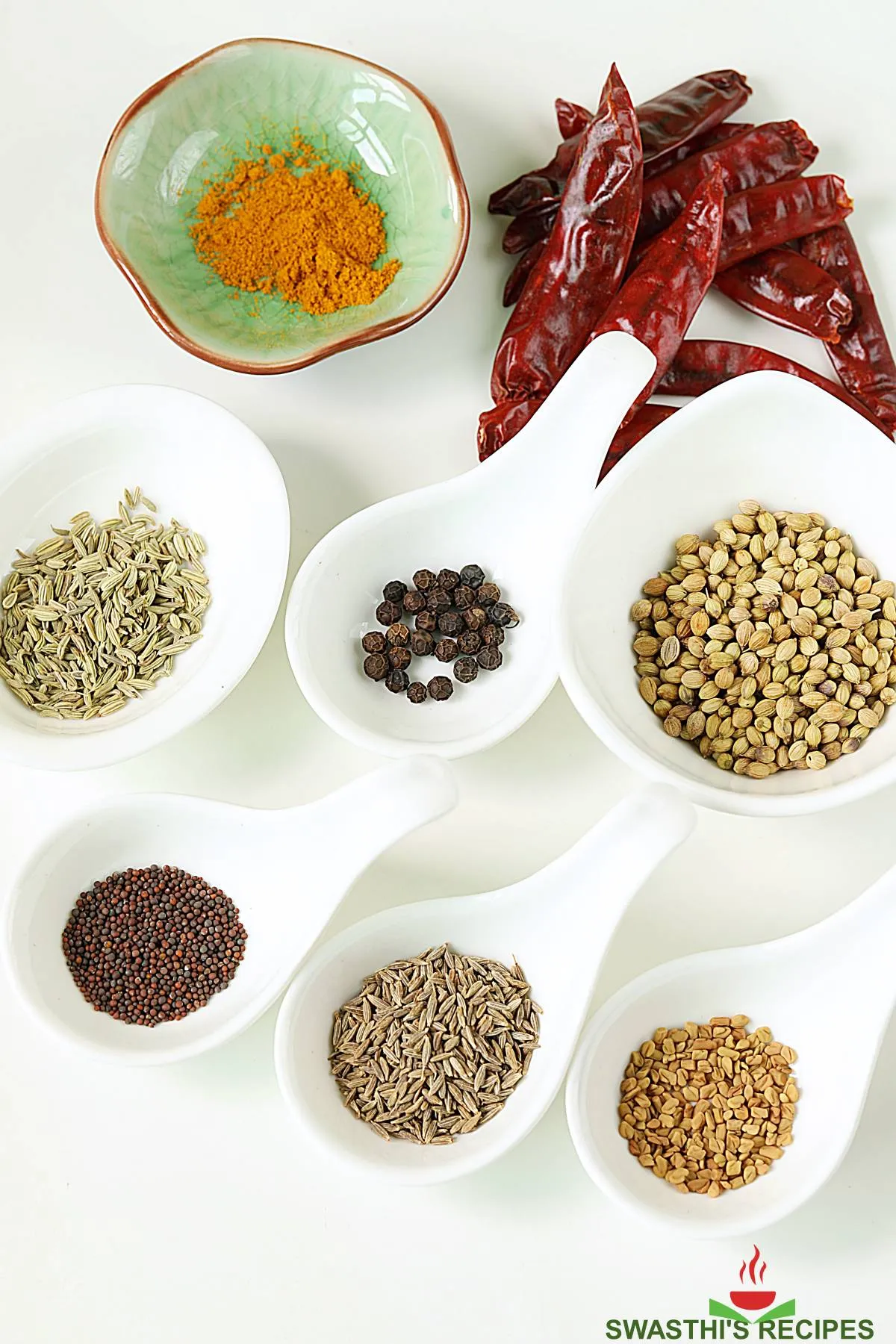
This homemade recipe is my perfected version that is based on the Telugu Koora Karam and Tamil Kulambu Thool but with minimal heat & a few extra Spices included for an extra zing!
So I wouldn’t call this a Kura karam or a kulambu thool which is made back home in India. The traditional version is super hot and it approximately comprises of 85% dried red chilies, 5% coriander seeds and 10% other ingredients.
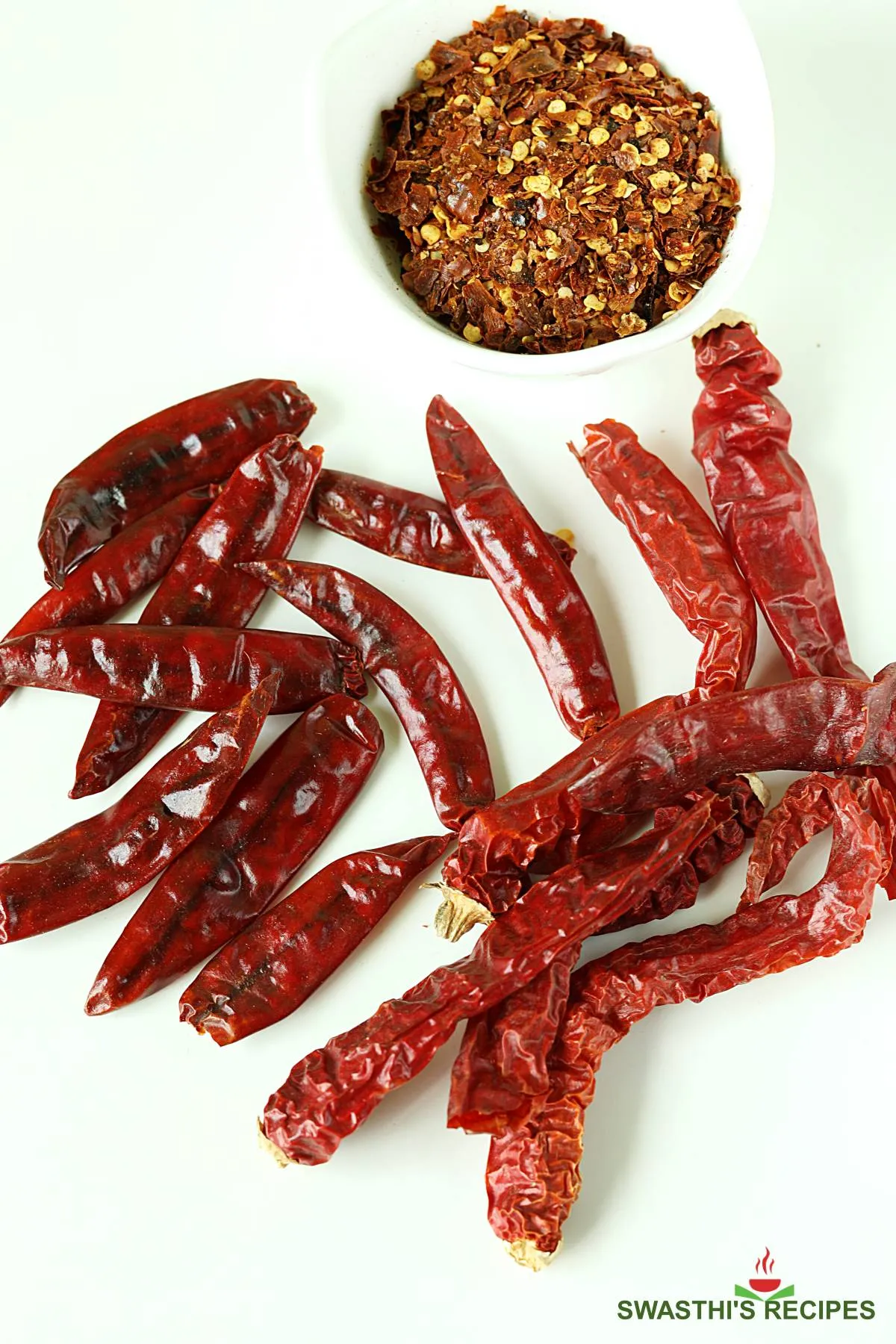
A traditional curry powder does not include stronger spices like black cardamoms, mace, nutmeg, star anise or caraway seeds which makes it a stronger blend similar to garam masala and biryani masala.
Though spices like green cardamoms, cloves and cinnamon are also not part of the traditional curry powder I love using them as it gives me the flexibility to flavor many more dishes. You will also find these spices in many store bought Asian Curry Powder.
Without these extra spices my curry powder tasted and smelled like Sambar Powder.
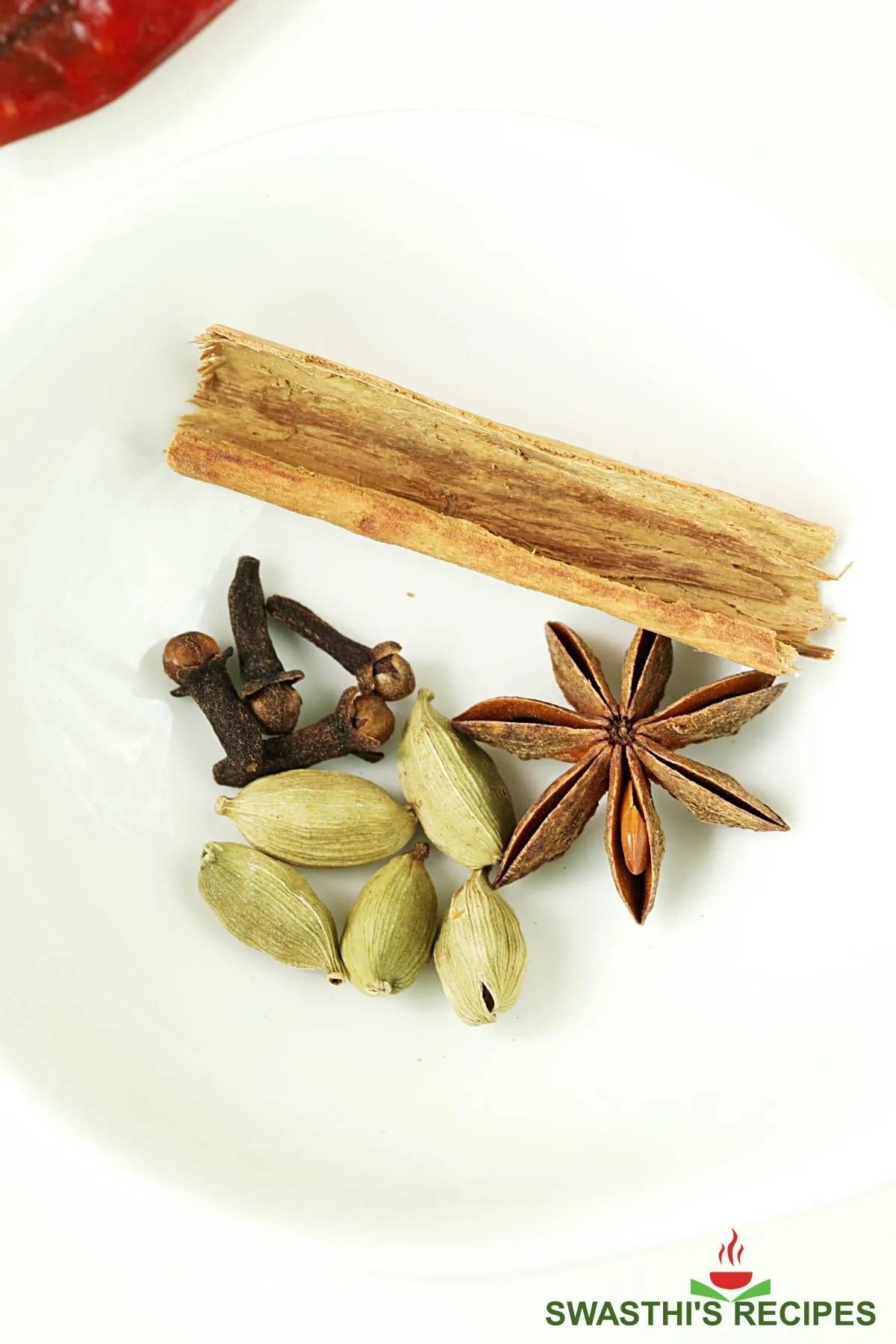
Why use Curry Powder over Garam Masala?
Indians don’t use garam masala in every other dish and in most households it is not an ingredient used every day. The reason being too many spices can cause digestive/stomach problems, can dehydrate the body and also mainly because we think it is unnecessary.
We also prefer the flavor of the star ingredient (e.g. vegetables/ lentils) to shine through in vegetarian dishes which is lost if garam masala is used.
While garam masala imparts stronger flavors, curry powder serves the purpose with milder flavors, color & texture. Curry powder is used as an all-in-one spice blend, meaning you don’t need to reach out to so many jars of spices, while making a curry.
More similar recipes
Chai Spice Recipe
Garam Masala
Biryani Masala
Cumin Powder
Photo Guide
How to Make Mild Curry Powder (Stepwise Photos)
1. Heat a pan and add 2 tablespoons (10 grams) coriander seeds, ½ teaspoon (1 gram) black pepper, 3 to 4 dried red chilies (deseeded for low heat), 1 star anise, 1 (1 gram) two inch piece cinnamon, 4 cloves and 5 (2 grams) cardamoms. Toast them (do not brown) on a low to medium heat until coriander seeds turn crunchy. Add the ½ tablespoon (5 grams) cumin seeds and 1½ teaspoon (4.5 grams) fennel seeds. Toast until they begin to smell earthy. Transfer to a cooling tray.
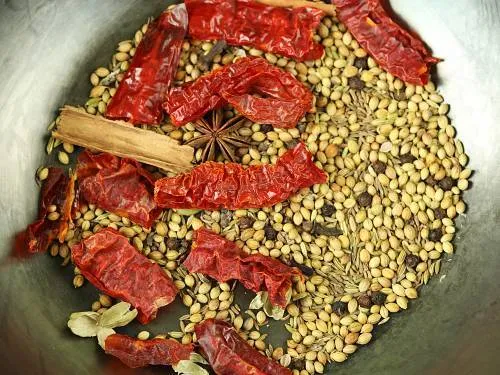
2. To the same pan add ½ teaspoon (2 grams) fenugreek seeds and roast on a low heat until they change their color to deep golden & begin to smell nutty/aromatic. Be careful as these can lend a bitter taste to your curry if they are overtoasted or undertoasted. Add the ½ teaspoon (2 grams) mustard and keep stirring just for a minute. Remove them to the tray.
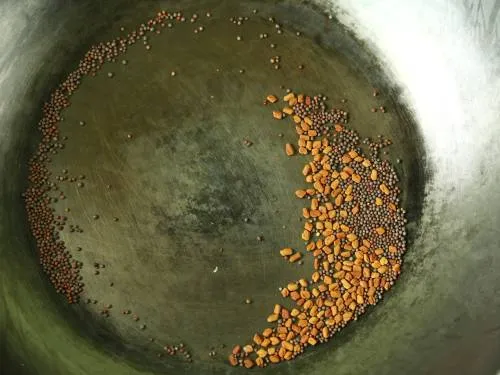
3. Roast 1 tablespoon (14 grams) Bengal gram/ urad dal – lentils/raw rice on a low to medium heat until aromatic, deep golden or light brown. If using rice, you won’t brown them. Transfer to the cooling tray. Adding more lentils will take you close to sambar powder.
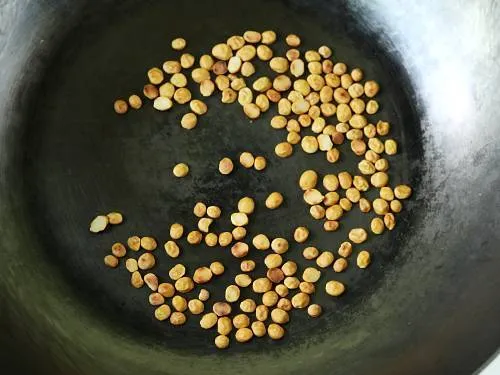
4. Add 10 to 20 curry leaves and toast them until crisp. Turn off and transfer to the tray. The picture shows more curry leaves but don’t use more than 20.
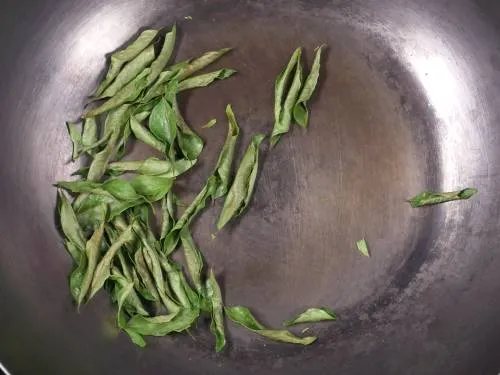
5. Add ¼ teaspoon organic turmeric and ½ teaspoon dried ginger (optional) to grinder jar along with all the cooled ingredients. Powder them fine. Cool down if the curry powder is warm. If you use a lot of turmeric it can stain your grinder jar. Also you may keep aside some of the toasted chilies and use after taste testing the powder. I use only 2 deseeded chilies.
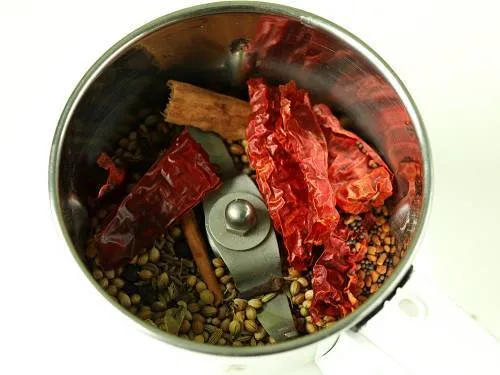
6. Transfer to an air tight glass jar and use as needed. If making a larger batch, store in smaller jars so it remains fresh for longer. This recipe makes about 6 tablespoons.
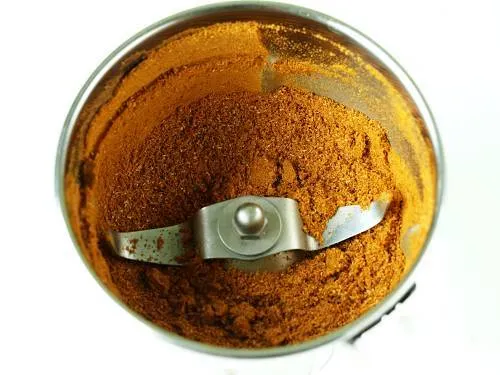
How to use Curry Spice Blend
Use ½ tablespoon per serving in vegetarian stir fry dishes and 3/4 tablespoon in curries and stews. You can use more if you want but keep in mind that your dish can become hot if you have included red chilies/ flakes/powder. Note that curry powder is mild and won’t impart stronger flavors like garam masala/ meat masala.
To use in meat dishes, top up with garam masala as required. You don’t need to add other spices individually like coriander powder, cumin powder, turmeric etc. You can also use this in a lentil or any vegetarian dish without garam masala (depending on the recipe).
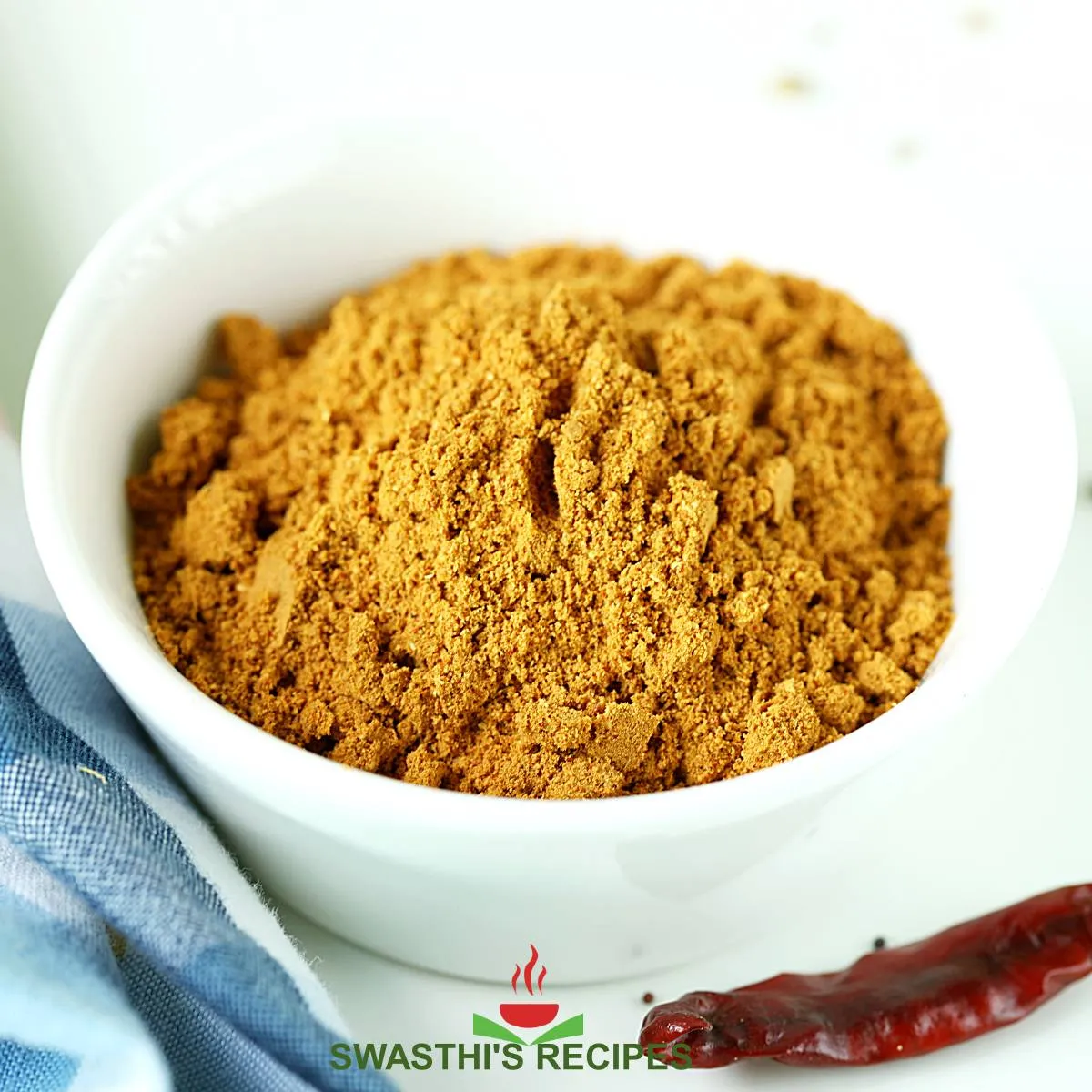
Ingredients & Substitutes
- Curry leaves: As the name says curry leaves are the key ingredient in this curry powder. It is best to use fresh or frozen curry leaves. If that is not available, double the amount and use dried leaves but I can’t guarantee.
- Lentils: Also known as dal are another key ingredient in the curry powder. It not only adds flavor and a creamy texture to the curries but also works as a healthy thickener. Here we use chana dal – Bengal gram & it can be substituted with split pigeon peas (toor dal), skinned urad dal or red lentils. But the flavor changes.
- Spices: I prefer using whole spices to make my curry powder for 2 reasons. I always stock up whole spices and don’t prefer to buy ground since they oxidize and lose their flavor soon. If you want to make your curry powder with ground spices, you may use the same quantities mentioned in grams.
- Dried Red Chilies: I use low heat Mathania chilies. You can use Kashmiri for low heat or Byadgi for medium heat or any other of choice. To make a hot curry powder, use hot chilies instead of increasing the quantity. We found this way the flavors are more balanced. Using a lot of chilies will impart more chili flavor to the powder & will go closer to the traditional thool/ karam.
- Ginger: A lot of times I do not include dry ginger in my curry powder because I love using fresh ginger over dried. Also note that both add different kind of flavors. So you can use dried here and still use fresh while cooking. Using dried ginger too often can dehydrate and cause constipation in a lot of people. So use with caution.
Related Recipes
Recipe Card for Mild Curry Powder
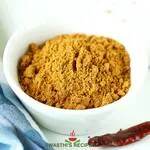
Curry Powder Recipe
For best results follow the step-by-step photos above the recipe card
Ingredients (US cup = 240ml )
- 2 to 3 dried red chilies (use more for heat, or chili powder / flakes to taste)
- 2 tablespoons (10 grams) coriander seeds
- ½ tablespoon (5 grams) cumin seeds
- 1½ teaspoon (4.5 grams) fennel seeds
- ½ teaspoon (2 grams) fenugreek seeds
- ½ teaspoon (2 grams) mustard seeds
- ½ teaspoon (1 gram) black pepper corn (use more for flavor & heat)
- ¼ teaspoon organic turmeric
- 1 tablespoon (14 grams) Bengal gram / chana dal sub with toor dal/ urad dal/ rice
- 1 to 2 (10 to 20 leaves) sprigs curry leaves
- ½ teaspoon organic ground ginger (optional)
SPICES you can double for extra flavor
- 1 star anise
- 5 (2 grams) green cardamoms
- 1 (1 gram) two inch piece Ceylon cinnamon (not cassia)
- 4 cloves
Instructions
How to Make Curry Powder
- Add coriander seeds, black pepper, dried red chilies, star anise, cinnamon, cloves and cardamoms to a hot pan. Roast them on a low to medium heat until coriander seeds turn crunchy.
- To the same pan, add cumin seeds and fennel seeds. Toast until they begin to smell earthy. Remove to a cooling tray.
- Add fenugreek seeds and toast on a low heat until they change their color to deep golden & begin to smell nutty. Stir in the mustard and toast just for a minute. Transfer to the cooling tray.
- Roast the lentils/raw rice on a low to medium heat until aromatic, deep golden or light brown. Transfer to the cooling tray. If using rice, do not brown.
- Add the curry leaves and toast them until crisp. Turn off and transfer.
- Add the turmeric and dried ginger if using to a grinder jar along with all the cooled ingredients. Powder them fine.
- Transfer to an air tight glass jar and use as needed. If making a larger batch, store in smaller jars to retain the freshness.
Notes
- Nutritional values are per tablespoon.
- If you leave out cardamoms, cloves, cinnamon and star anise, your curry powder will smell more like a Sambar powder. Your curry will smell like sambar.
- You may substitute chana dal with other lentils but we felt the flavors are best with these.
- Use your favorite kind of chilies. For a high heat curry powder, use hot chilies instead of increasing the quantity of chilies. This way the flavors are more balanced.
- It is important to toast the spices in batches/ separately as mentioned in the recipe because the toasting time is different.
NUTRITION INFO (estimation only)
© Swasthi’s Recipes
Recipe Card for Madras Curry Powder
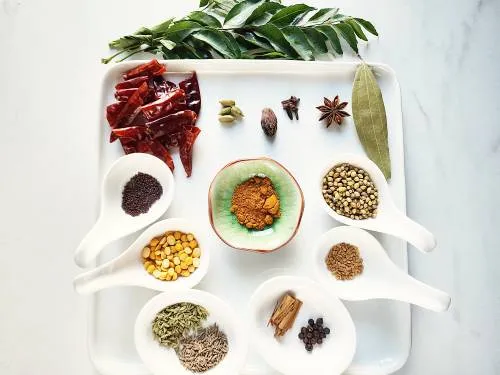
Madras Curry Powder
For best results follow the step-by-step photos above the recipe card
Ingredients (US cup = 240ml )
- 10 dried red chilies (deseeded for less heat)
- 1 tablespoon (5 grams) coriander seeds
- ¾ teaspoon (2½ grams) cumin seeds
- ¾ teaspoon (2 ¼ grams) fennel seeds
- ¼ teaspoon (1 gram) fenugreek seeds
- ¼ teaspoon (1 gram) mustard seeds
- ¼ teaspoon (½ gram) black pepper corn (use more for flavor & heat)
- ⅛ teaspoon organic turmeric
- ½ tablespoon (7 grams) Bengal gram / chana dal sub with toor dal/ urad dal/ rice
- 3 sprigs curry leaves (pat dry)
- 1 bay leaf
- 4 green cardamoms
- 1 inch Ceylon cinnamon quill (not cassia)
- 4 cloves
- 1 star anise
- 1 black cardamom
Instructions
- On a low to medium heat, toast coriander seeds, black pepper, dried red chilies, star anise, cinnamon, cloves, green cardamoms and black cardamom until coriander seeds turn crunchy.
- Add cumin seeds and fennel seeds. Toast until they begin to smell earthy. Remove to a cooling tray.
- Add fenugreek seeds and toast on a low heat until they change their color to deep golden & begin to smell nutty. Stir in the mustard and toast just for a minute. Transfer to the cooling tray.
- Roast chana dal on a low to medium heat until aromatic, deep golden or light brown. Transfer to the cooling tray.
- Add the curry leaves and toast them until crisp. Turn off and transfer.
- Add the turmeric to a grinder jar along with all the cooled ingredients. Powder them fine.
- Transfer to an air tight glass jar and use as needed. If making a larger batch, store in smaller jars to retain the freshness.
© Swasthi’s Recipes
About Swasthi
I’m Swasthi Shreekanth, the recipe developer, food photographer & food writer behind Swasthi’s Recipes. My aim is to help you cook great Indian food with my time-tested recipes. After 2 decades of experience in practical Indian cooking I started this blog to help people cook better & more often at home. Whether you are a novice or an experienced cook I am sure Swasthi’s Recipes will assist you to enhance your cooking skills. More about me
Follow Swasthi’s Recipes

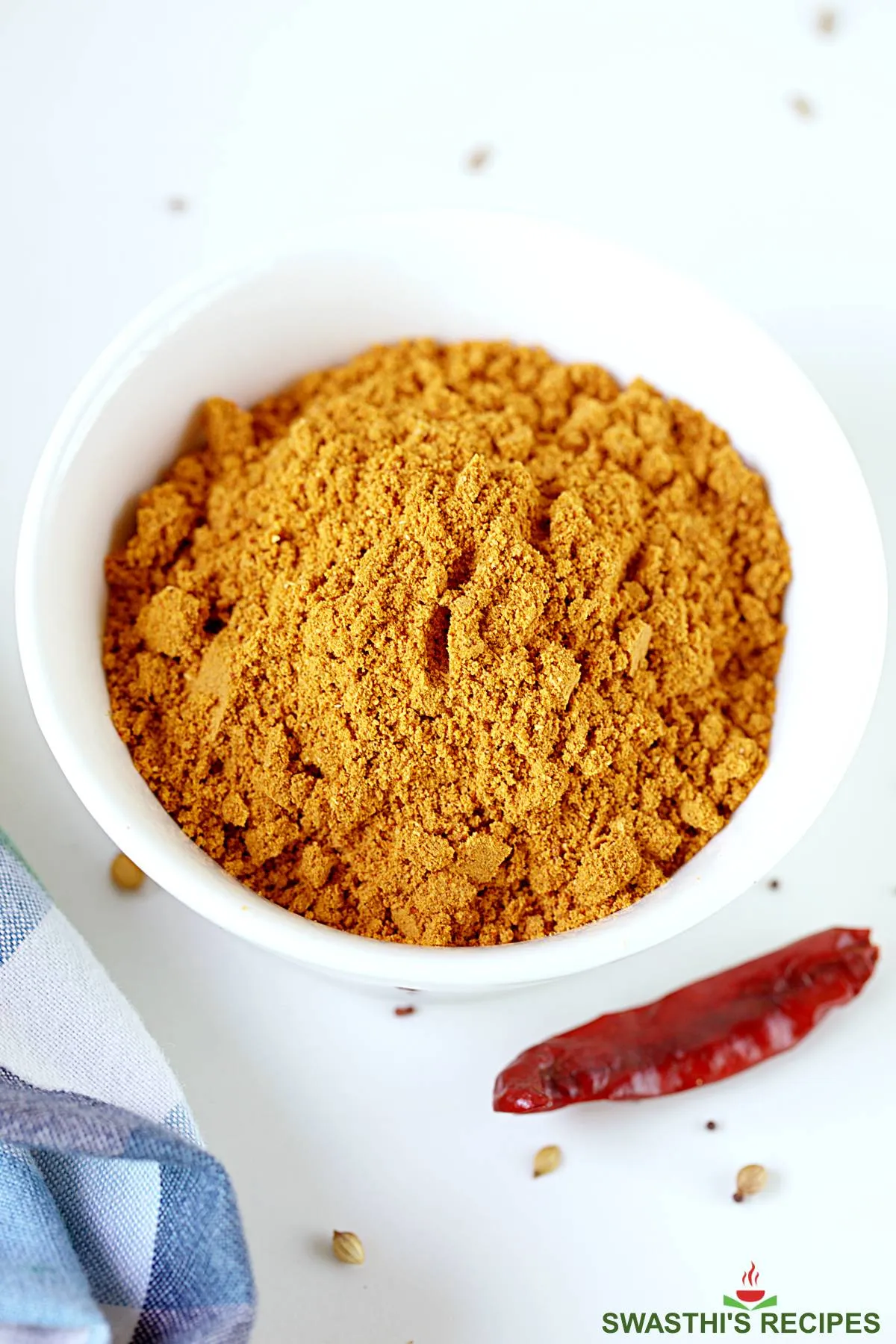
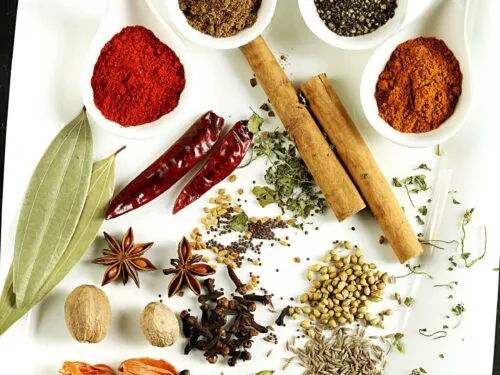
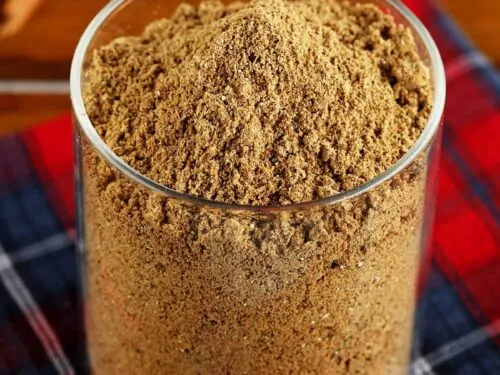
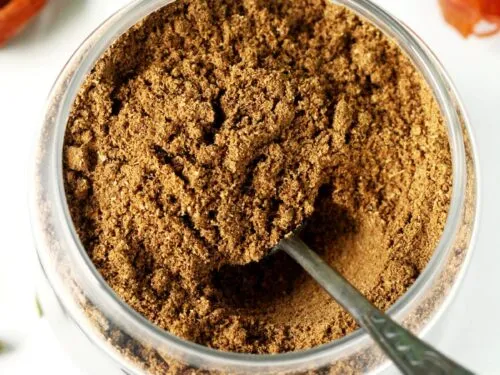
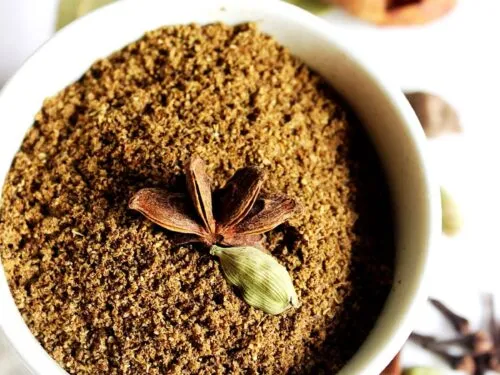
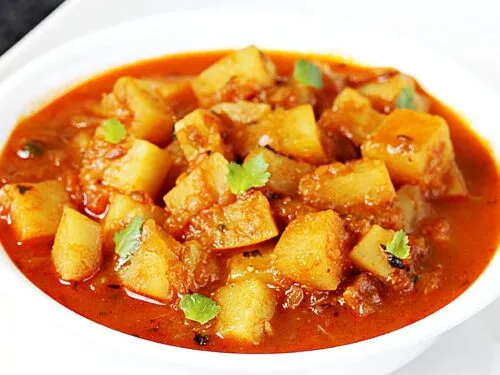
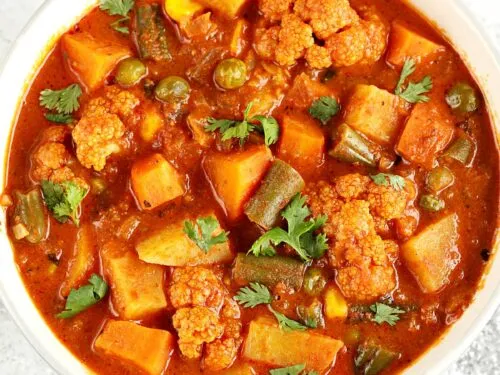
Comments
Hi. I am from the UK and wanted to say thank you for your blog. I’ve been using it for a couple years and to have access to genuine Indian recipes is so great.
I have always been interested in Indian food and think it’s a shame English chefs without proper knowledge of the cuisine are always at the top of google.
This blog has been great for somebody who just wants to learn from the culture directly.
Thanks again 🥰
Hi Christopher,
You are most welcome! Happy to know the recipes have been useful. Thank you for the support!
OMG! The madras curry powder is so good. Made it last month and have been using in many recipes. Thank you
Thank you Susy. So glad to read that!
Hi Swasthi, thanks for the recipe. I would refer to use kashmiri powder in this recipe. How much should I use in the place of the red chillis?
Cheers
Hi Elisheba,
Actually you can completely omit the chilies here and add chili powder when you make the curry (as per the curry recipe). But if you still want to include, use 1½ teaspoon Kashmiri chili powder. Cut down to 1 tsp if you want a low heat blend. Hope this helps
I have made both the versions of curry powder and can’t say one is better over the other. Each aromatic in their own way. So far I have made potato curry and chickpea curry with your first recipe and madras chicken with the second. Both exceeded my expectations. Thank you for sharing your recipes with us.
H Kevin,
Wow, that’s so nice to know. Glad you like them. Thank you for trying and sharing back.
I have made this twice and it is absolutely amazing. After you grind it up the aroma fills the entire kitchen.
Thank you Andy. Happy to read that
I’ve recently started making my own curry powder with whole spices and this recipe worked fantastic for our tastebuds. Being able to adjust the heat levels is the biggest plus for me and I am excited to try out different kinds of curry powders like curry masala powder, fish curry powder and madras curry powder. Will you be able to share those? Thank you for the recipe.
Hi Ben,
Glad the recipe worked for you. If you exclude the optional spices it is a basic curry powder. If you include them it is curry masala powder. Fish curry powder is just a different spice blend which I haven’t tried yet. Madras curry powder recipe is coming up soon on the blog. Hope you give it a try. Thank you
Love all the information you shared about curry powder and its origin. We have been restricting ourselves from store bought spice blends. The added salt and don’t know what not, troubles my tummy. So I usually toast and soak the whole spices, which I grind to a coarse paste. I have been doing this for 2 years. It goes well in curries, dal and stew. Last week I made you chettinad masala paste from your kulambu recipe. My husband said it is the best and it smells divine. I am going to try your curry powder soon. I am waiting for the gram dal to be delivered. Hope it turns out as good as your chettinad masala.
Thank you Mary. Happy to read you like the chettinad masala. Hope you like this one too.
Swasthi, I followed your advice and the curry came out delicious. Thank you for being a trustable source.
That’s nice to know! Thank you for sharing back
I made this curry powder to cook my coconut curry chicken and it was fabulous. I’ve made curry thrice since finding your recipe and all the times it was delicious. This recipe makes very little so I would double the ingredients next time.
Thank you Ivana. Glad it worked out well.
I made this curry powder and yet to use it. How much can I use in your chickpea curry recipe? Would you still use garam masala, cumin and coriander? Please advice
Hi Arjun,
You don’t need to add any other spices like turmeric, coriander, cumin, and chili (unless you want more heat). Add 2 to 2.5 tablespoons curry powder and garam masala (about 1/2 to 1 tsp) only if you want at the finishing stage. Hope this helps. Would love to hear how it turns out for you.
This is more fragrant than the kulambu masala I buy. I tried the exact recipe with 20 chilies and doubled those spices you mentioned. Right now I am making fish curry and my house smells amazing.
Jyoti,
That’s nice to know! Thank you for trying so many recipes and sharing back!
Excellent recipe. Thank you for sharing your Indian curry culture. But what kind of spice grinder do you use?
Thanks Pauline. I use a grinder with a steel jar. This kind of appliance is known as mixer/grinder & can also blend lentil batter, curry/sauce , chutney etc. They are very common in the Indian households.
Curry powder sounds so exciting to me. Will surely give it a try! Do you use this with the whole spices like mustard and cumin seeds. Would love to see how you make use of it. Please share
Hi Suneha,
Using whole spices is optional while using this curry powder. I make a 6 ingredient fast curry with this blend which does not include any whole spices and even ground spices. Yes sure I will share a recipe.